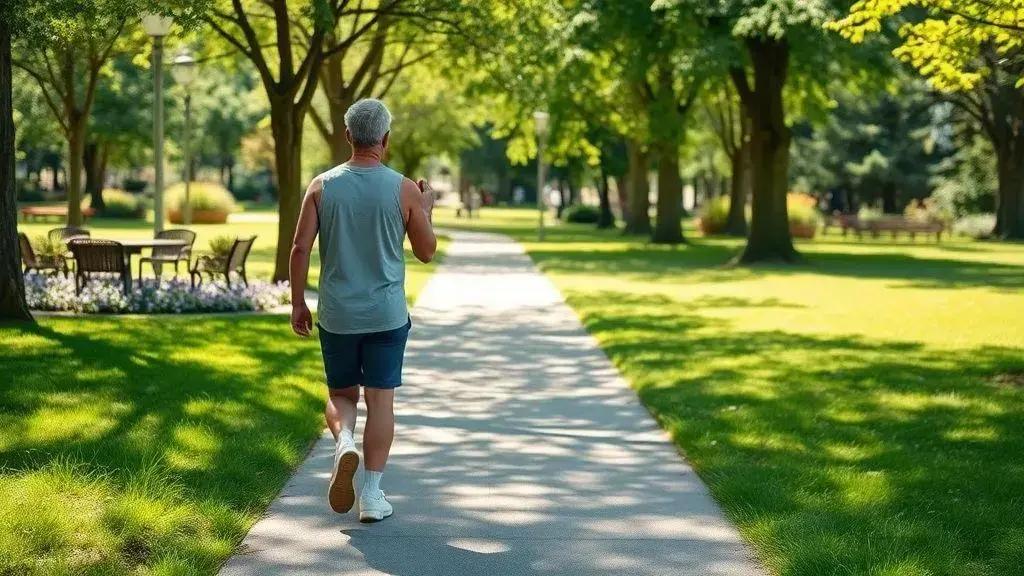Mindful walking practices for daily calm and clarity

Mindful walking practices for daily calm involve walking with awareness, focusing on your breathing and surroundings to enhance relaxation and emotional well-being while integrating this simple practice into your everyday routine.
Mindful walking practices for daily calm offer a unique way to reconnect with yourself while navigating the hustle and bustle of everyday life. Have you ever noticed how taking a moment to walk mindfully could shift your mood? Let’s dive into how this simple practice can make a big difference.
Understanding the principles of mindful walking
Understanding the principles of mindful walking is essential for anyone looking to incorporate this calming practice into their daily routine. At its core, mindful walking encourages us to be present and aware of our surroundings while moving.
The first principle to grasp is awareness of breath. As you start walking, take a moment to focus on your breathing. Notice the rhythm of your inhale and exhale. This simple act can help anchor your thoughts and bring you into the moment.
Being present in the moment
Another fundamental aspect is being present. Shift your attention to the sensations in your body. Feel the ground beneath your feet and the movement of your legs. Allow the experience of walking to envelop you.
Engaging the senses
Engaging your senses adds richness to your experience. What do you see, hear, or smell? Notice the colors of the leaves or the sound of birds chirping. These elements enhance your connection with nature and help clear your mind.
Benefits of mindful walking
- Reduces stress and anxiety.
- Improves focus and concentration.
- Enhances emotional well-being.
- Fosters deeper connections with the environment.
Lastly, practice patience with yourself. Mindful walking is a journey, not a destination. Allow yourself to grow comfortable with each step. As you embrace these principles, you will discover peace in your daily walks, turning a simple activity into a meaningful practice.
Techniques to enhance your walking experience

Techniques to enhance your walking experience can transform a simple stroll into a meaningful practice. Implementing various strategies helps you fully immerse yourself in the joy of walking.
One effective technique is to focus on your posture. Standing up straight can improve your breathing and help you feel more energized. Imagine your head floating above your shoulders and your feet firmly planted on the ground, creating a solid foundation.
Meditative breathing
Next, consider integrating meditative breathing into your walks. Inhale deeply through your nose, hold for a few seconds, and exhale slowly through your mouth. This practice calms your mind and brings awareness to your body.
Walking with intention
Walking with intention is another powerful technique. Set a purpose for each walk, whether it’s to clear your mind, appreciate nature, or simply enjoy the fresh air. This clarity can make the experience more fulfilling.
Mindful stretch breaks
- Take frequent stretch breaks to release tension.
- Incorporate simple stretches for your legs and back.
- Use these moments to appreciate your surroundings.
- Focus on the sensations in your body while stretching.
Additionally, try varying your routes. Exploring new paths can keep your walks interesting and expose you to different sights and sounds. This not only invigorates your walking routine but also allows for moments of discovery.
Creating a mindful walking routine
Creating a mindful walking routine can enhance your life significantly by allowing you to connect with the world around you. By establishing a regular practice, you open the door to greater awareness and peace.
Start by choosing a time that works for you. Whether it’s in the morning to kickstart your day or in the evening to unwind, consistency is key. Try to commit to at least 15 to 30 minutes each time, which is enough to feel the benefits.
Finding the right location
The next step is selecting a suitable location. Choose a space that feels safe and pleasant, such as a park, a beach, or even quiet streets. Natural surroundings can inspire a deep sense of peace and connection.
Setting an intention
Before you begin, take a moment to set an intention. This could be a simple reminder to stay present or a focus on gratitude. As you walk, gently bring your mind back to this intention whenever you find it wandering.
Incorporating mindfulness techniques
- Pay attention to your footsteps and the rhythm of your body.
- Breathe deeply, focusing on the in and out.
- Observe the sights, sounds, and smells around you.
- Take moments to pause and reflect on your experience.
Recording your experiences can strengthen your practice. Consider keeping a journal where you note insights, feelings, or observations after each walk. This can help reinforce your commitment and track your progress.
Finally, invite others to join you. Walking with a friend or loved one can provide additional support and make the experience more enjoyable. Encourage discussions about mindfulness or simply share the quiet moments. Each of these steps will help to create a sustainable, enriching mindful walking routine.
Integrating mindful walking into daily life

Integrating mindful walking into daily life can greatly enhance your overall well-being. This practice allows you to find calm and connection even amid a busy schedule.
One effective way to incorporate mindful walking is to turn everyday errands into opportunities for mindfulness. For example, whether walking to the store or heading to work, take a moment to focus on your steps and breathe deeply as you move. This practice helps create a sense of awareness while performing routine activities.
Setting reminders
Another beneficial strategy is to set reminders throughout your day. Use your phone or post-it notes to remind yourself to take short, mindful breaks. Even a five-minute walk during your lunch break can refresh your mind and body.
Creating a walking schedule
Consider creating a specific walking schedule that includes both leisure and purpose. Schedule time for walking in your week. It could be early in the morning, during lunch, or after dinner. Having a designated time encourages you to stick with your routine.
Incorporating mindful walking with others
- Invite friends or family to join you on walks.
- Combine walking with social time, discussing your goals or gratitude.
- Attend walking groups or classes focused on mindfulness.
- Make it a community activity to support your practice.
Combining mindfulness with movement helps shift your focus from distractions to your immediate surroundings. As you move, pay attention to the details around you. Notice colors, shapes, and sounds. This level of awareness enriches both your mental state and your physical health.
Lastly, connect your mindful walks with nature. Spending time in green spaces can enhance the benefits of mindfulness. Whether in your backyard or a nearby park, being in nature allows you to feel grounded and relaxed.
mindful walking into your daily life can lead to greater peace and clarity. By making small adjustments to your routine, you can enhance your awareness and overall well-being. Whether you’re walking during errands or setting aside time specifically for mindfulness, every bit counts. Remember to embrace nature, connect with others, and keep your intention clear as you walk. With consistent practice, you will notice positive changes in your mindset and emotional health.
FAQ – Questions About Mindful Walking Practices
What is mindful walking?
Mindful walking is a practice where you walk with awareness, focusing on your breath, movements, and surroundings to enhance presence and calm.
How can I integrate mindful walking into my daily life?
You can incorporate mindful walking by taking short walks during breaks, setting a specific time for walking, and turning errands into mindful experiences.
What are the benefits of practicing mindful walking?
Mindful walking can reduce stress, improve focus, enhance emotional well-being, and bring a greater sense of connection to your environment.
Is mindful walking suitable for everyone?
Yes, mindful walking is accessible to all ages and fitness levels; it can be tailored to fit individual needs and preferences.





